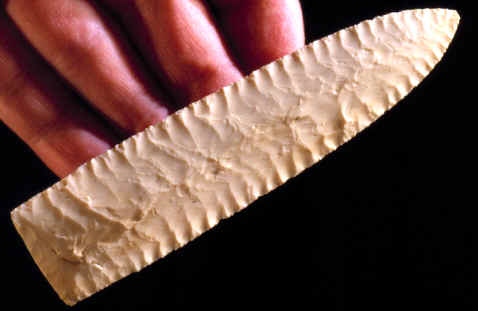FIRSTVIEW POINTS
This point was purchased from a rancher many years ago in northwestern
Texas. It's been well known among collectors and a few archaeologist for
quite some time and is recognized as one of the best Firstview style Eden
points ever found. This point was skillfully made with uniform parallel
pressure flaking. It also has a pronounced diamond cross section that is
a major diagnostic trait of Eden points which is one of the reasons that
Firstview points may be thought of just a variety of Eden point. This
example represents a newly made spear point that was apparently never
damaged before it was lost by its original owner thousands of years ago.
The very slight shoulders are the result from only grinding that was
done to the hafting or basal area. This Firstview point is made of a
white chert of fairly good quality and measures 4 3/8 inches long. by Bruce Bradley PhD.
This projectile point was produced by a series of controlled flaking
stages. The first stage was the production of a biface by controlled
percussion flaking. A stage of controlled but selective pressure flaking
was then done to make the biface extremely regular and eliminate
irregular surface contours. Once this was accomplished each side of the
biface was flaked by the removal of a series of pressure flakes which
terminated at or near the midline of the preform. Extreme care had to be
taken both with platform preparation along the edges and with flake
removals. Two or three series of pressure flakes were removed from each
face and edge of the point to obtain the regularity in flaking pattern
that is evident on this point. It was finished by very fine selective
pressure retouch which was also used to produce the indentations of the
stem. The stem edges and the base were slightly abraded. |
Joe Ben Wheat
&
First View points were named by Joe Ben Wheat after the town of
Firstview, Colorado. He discovered these Eden-like projectile points on
the Olsen-Chubbuck site which is located 10.5 miles southeast of the
town of Firstview in Cheyenne Co., Colorado. Olsen-Chubbuck is a
Paleo-Indian kill and butchering site that once contained 190 extinct
long-horned bison. The bone bed was first discovered by the owner of the
land, Paul Forward, after wind erosion uncovered many of the bones. The
first projectile point was discovered by Jerry Chubbuck one day when he
noticed the heavily eroded while driving by one day and decided to
investigate. The site was excavated within two digging seasons. The
first in 1958 and the second in 1960 by Joe Ben Wheat under the auspices
of the University of Colorado Museum. The last one of the many thousands
of bones that were removed there was done on August 20, 1960. |
|
References:
1972, "The Olsen-Chubbuck Site", Joe Ben Wheat, pp 1, 3-4,
125-138. |
